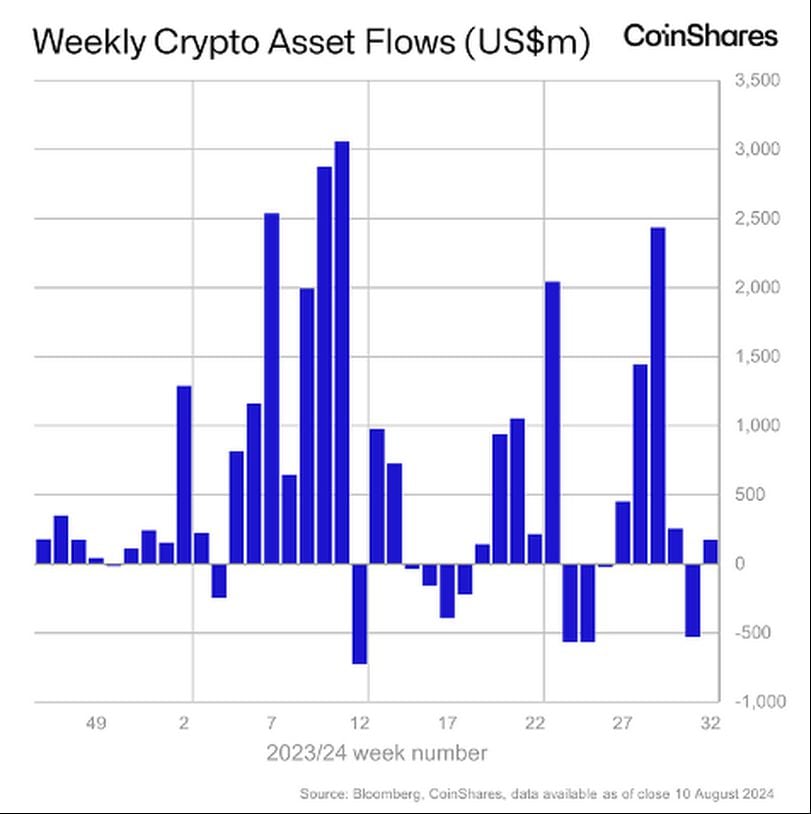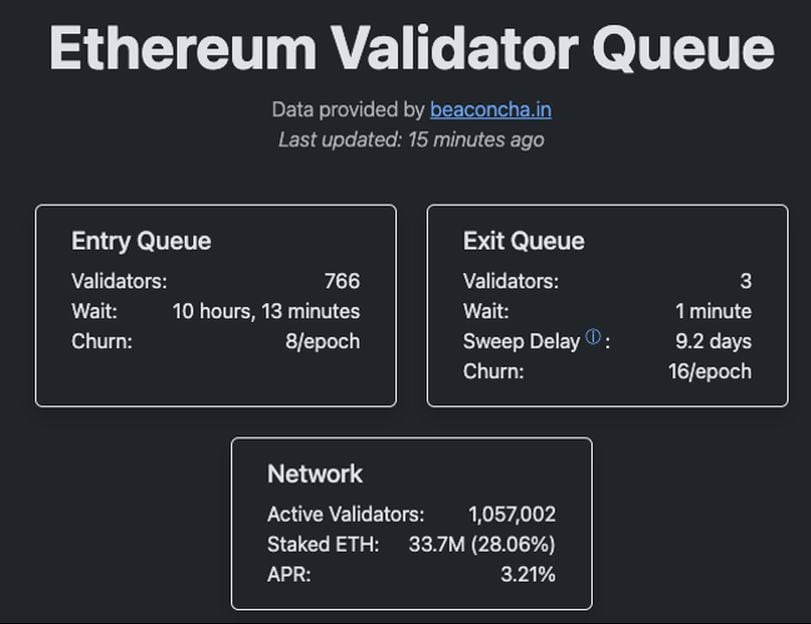News
Crypto for Advisors: Crypto Market - A Week in Review
In today’s issue, Xinghua Luo from Pioneer Asset Management Limited provides a summary of market activity including a US Inflation Rate and Federal Reserve Outlook, ETF Developments and overall crypto flows.
Then, Jason Leibowitz from Hashnote provides insights about market trends and the hunt for yield in Ask an Expert.
- Sarah Morton
You’re reading Crypto for Advisors , CoinDesk’s weekly newsletter that unpacks digital assets for financial advisors. Subscribe here to get it every Thursday.
Weekly Crypto Market Review
Recently, the digital asset market saw little movement after cryptocurrencies were not discussed during the highly anticipated X space between Elon Musk and Donald Trump. BTC hovered around $58,750, down just over 1% from the previous day. The broader crypto market, represented by the CoinDesk 20 Index, experienced a similar decline. Despite high expectations from the crypto community and a 65% chance bet on Polymarket for "crypto" being mentioned, the topic never came up during the two-hour interview, which drew over 1 million listeners.
US Inflation Rate & Federal Reserve Outlook
The next U.S. FOMC meeting will take place on Sept. 18. As a result of the recent market rout, the market now expects the Federal Reserve to begin rate cuts in September, with about 100 basis points (bps) cut by the end of December. The Consumer Price Index (CPI) year-over-year is expected to stay at 3.0% for July's data release, while Core CPI year-over-year is expected to decrease from 3.3% to 3.2%. As usual, the Fed will not rush to make decisions but rather monitor economic data first. They are now stuck between increasing credits and fighting inflation.
ETF Developments
On Monday, U.S.-listed spot Ether ETFs saw a net inflow of $4.93 million, with Fidelity's FETH leading at $3.98 million. Franklin Templeton's EZET and Bitwise's ETHW posted inflows of $1 million and $2.86 million, respectively, while VanEck's ETHV saw an outflow of $2.92 million. Bitcoin ETFs, collectively, had a daily inflow of $27.87 million, despite Grayscale's GBTC and Bitwise's BITB recording outflows of $11.7 million and $17 million, respectively. Grayscale's two Ether funds showed no flows.
BTC & ETH Option Flows
The week saw successful hedge/bear plays targeting $54-58K puts, with funds adding exposure to Oct-Mar $60-65K calls on the rebound. While short-term put-skew shows caution, long-term call bulls remain strong, with the market awaiting Producer Price Index (PPI) and CPI data.
Although near-term volatility and skew have been retraced, long-term calls and spreads were not adjusted; instead, they increased. There's confidence in buying upside, funded by selling <$45K Puts, but short-term protection around $48-50K persists.
Skew dynamics show elevated short-term put-skew, while longer-term calls trade at a premium.
ETH saw strong volumes with protection around $2-2.3K Strikes and later added $2.3-2.7K Calls, impacting IVs and raising the ETH-BTC Dvol spread.
Recent FOMC and JPow AMA were overshadowed by NFP, raising recession concerns. Upcoming PPI and CPI data will provide more insight into market trends. BTC DVOL is at 57.45%, while ETH DVOL is at 72.92%.
ETH Technical Analysis
On August 12, 2024, Ethereum (ETH) was valued at $2,683, fluctuating within a range of $2,523 to $2,720. Despite significant market activity, technical indicators suggest that ETH is facing difficulties breaking through resistance levels, indicating a potential bearish trend. Short-term recovery is noted, but maintaining levels above $2,700 remains a challenge, with a possible drop towards $2,600 if selling pressure increases. While some indicators show buying opportunities, the overall outlook is bearish, with caution advised for traders. Ethereum's future movement will depend on breaking above key levels like $2,800.
Weekly Crypto Asset Flows
Digital asset investment products experienced inflows totalling $176 million as investors viewed recent price declines as buying opportunities.
Ethereum saw the most significant benefit from the market correction, drawing $155 million in inflows, bringing its year-to-date total to $862 million.

ETH Staking Statistics
ETH staking new validator activation takes 10 hours and 13 minutes, while the ETH exit queue is very short at 1 minute, showing that there is more interest in staking now.
The total amount of ETH staked is currently 28.06%, and the recent staking reward is 3.21% p.a. Compared with the Decentralized liquid staking solution, Lido’s market share still dominates at 71.56%.

In summary, the crypto market may still be sideways and volatile for a while as the market is speculating on the Fed’s September rate cut. Unfortunately, there is not much good news that could stimulate and send the market up to 70K soon. It is not surprising to see that yields generated from staking or other products are more welcomed than putting in ETFs.
- Xinghua Luo, Managing Director, Pioneer Asset Management Limited
The views, thoughts, and opinions expressed in this column belong solely to the author.
Ask an Expert
Q. How has the dispersion in crypto returns evolved over the past year, and what are the key factors contributing to this trend?
Over the past year, crypto returns have exhibited notable dispersion, with assets like Bitcoin and Solana outperforming many others. This divergence marks a departure from previous cycles where gains were more evenly spread across the market. Key factors contributing to this trend include macroeconomic conditions such as tightening liquidity and rising interest rates, which have generally suppressed performance in riskier and less established assets. Additionally, the recent Bitcoin halving has played a role by reducing new supply, historically leading to prolonged periods of bullish activity where Bitcoin outperforms the other majors.
A significant factor in this dispersion is the shift away from lending as a primary yield-generating strategy. The previous crypto cycle saw the creation of a credit bubble fueled by lending, which ultimately burst, leaving investors wary of allowing their assets to leave custodianship. In response to this shift in investor sentiment, some of the most forward-looking funds have introduced safer yield-generating solutions by utilizing the derivatives market. Products like Harbor allow investors to earn returns on idle assets like Bitcoin through options strategies such as covered call spreads, all while keeping assets secure within a custodian's control. This approach offers a creative and secure alternative to the lending practices that defined the previous cycle.
Q. In what ways have stablecoins and a hunt for yield influenced the current state of crypto market dispersion?
Stablecoins and the hunt for yield have significantly influenced the current state of crypto market dispersion. Stablecoins provide a stable medium of exchange and store of value within the volatile crypto ecosystem, facilitating seamless trading and access to DeFi services. However, while stablecoins offer stability, they generally do not provide any yield to investors.
This is where tokenized money market funds have started to play a crucial role. These assets offer investors a way to earn stable, risk-mitigated returns by directly passing on the yields from short-term U.S. Treasury Bills. Tokenized money market funds bring the benefits of blockchain technology—such as transaction speed, transparency, and composability—while minimizing the protocol, custody, regulatory, and credit risks often associated with other token projects. The advent of these assets adds a new layer of stability and yield potential to the crypto ecosystem, contributing to the diversification of investor portfolios.
Despite the benefits of stablecoins and tokenized money markets, there remains a growing portion of the crypto economy in search of further yield, particularly among investors holding idle assets like Bitcoin. While lending was once a popular strategy, the bankruptcies and frauds in 2022 highlighted the substantial risks involved in lending platforms. As the market recovers from these setbacks, new companies are beginning to emerge, offering more robust, transparent, and secure lending platforms. These platforms claim to have learned from past mistakes, leading to better risk management practices and contributing to the overall dispersion seen across various crypto assets.
Q. Considering current trends and factors, what should investors be aware of regarding the future trajectory of crypto market dispersion?
Investors should recognize that crypto market dispersion will likely persist in the foreseeable future due to ongoing and emerging factors influencing the space. The upcoming U.S. presidential election introduces potential regulatory changes that could impact market sentiment and asset performance, depending on the policies of the elected administration. Additionally, technological advancements and differing levels of adoption across various blockchain ecosystems will continue to drive disparate outcomes among crypto assets.
Diversifying investment strategies through well-regulated and professionally managed funds can help mitigate risks and capitalize on opportunities across the spectrum of crypto assets. Emphasizing due diligence and a thorough understanding of individual asset fundamentals will be essential in navigating the evolving and segmented landscape of the crypto market.
- Jason Leibowitz, head of private wealth, Hashnote
Keep Reading
-
Franklin Templeton has extended it’s tokenized money market fund to the Avalanche blockchain.
-
The bitcoin ETFs saw $250M in net inflows , marking the highest since July.
-
The Cardano blockchain is heading towards a network fork to add governance features to the blockchain.

